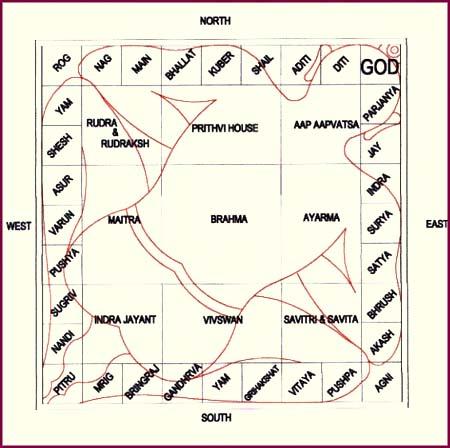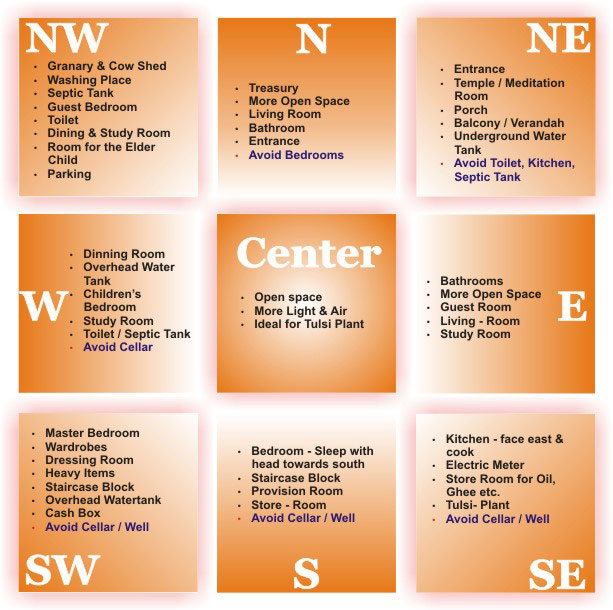
WHAT IS THE LEGEND OF VASTU PURUSHA?
The ancient Indian text Mayamatam on Vastu Sastra, written thousands of years ago, explains the legend of the Vastu Purusha. According to Hindu mythology, in the beginning Brahma the creator of the Universe, experimented with a new creature. He created a large cosmic man, who grew rapidly as he began to devour everything in his path to satisfy his insatiable hunger. When he became unmanageably big so that his shadow fell on the Earth like a permanent eclipse, the gods Shiva and Vishnu begged Brahma to do something before everything was destroyed by this Creature.
Brahma realised his mistake and called the Astha Dikapalakas – the Gods of the eight cardinal directions. Together, they overpowered the monster and held it flat against the Earth while Brahma jumped on it’s middle. Then the Monster cried out to Brahma, “You created me like this. So why am I being punished?” Brahma offered him a compromise and made the Monster immortal with the boon that he would be worshiped by any mortal that builds a structure on earth. He was named Vastu Purusha.
Vastu Shastra gives the directive principles regarding construction of buildings so as not to displease the Vastu Purusha. These principles are explained with the help of the diagram called the Vastu Purusha Mandala.

WHAT IS THE VASTU PURUSHA MANDALA?
The diagram shown above, known as Vastu Purusha Mandala, is a metaphysical square plan that illustrates how the Vastu Purusha was pinned down by Brahma and 44 Gods – face down, with his head to the North-East and his feet towards the South-West.
The diagram is divided into 9×9 = 81 parts. The positions of the 45 gods who are holding down the Vastu Purusha are shown. (32 in the external enclosures and 13 in the internal enclosures). These symbolic Gods rule various aspects of life and have certain inherent qualities. For example, there should be no weight on the central portion as it is ruled by Brahma, the supreme one. It is to be kept open in the form of a central courtyard. (This was mainly to allow proper flow of air and cross ventilation). The function of the rooms placed in each area of the house was in accordance with the nature of the deity ruling that particular area. This has been shown in the two examples given below:
THE DIAGRAM BELOW SHOWS THE IDEAL POSITIONS OF DIFFERENT ROOMS IN A SMALL HOUSE, BASED ON THE THE VASTU MANDALA GRID OF 3X3.

THE DIAGRAM BELOW SHOWS THE IDEAL POSITIONS OF DIFFERENT ROOMS IN A BIG HOUSE, BASED ON THE THE VASTU MANDALA GRID OF 5X5.
ACCORDING TO VASTU SHASTRA, WHAT ARE THE ADVANTAGES OF DESIGNING A HOUSE BASED ON THE VASTU PURUSHA MANDALA?
According to Vastu Shastra, if the house is designed as per the Vastu Purusha Mandala, a perfectly balanced environment which ensures enhanced health, wealth and happiness is created. The Scientific Explanation: This is actually based on scientific principles wherein, the Sun, the five basic elements (panchabhutaas), the Earth’s magnetic field, Earth’s energy fields,and the eight directions are manipulated to create an atmosphere beneficial to man. The Vastu pundits figured out that, when the different rooms were placed according to the Vastu Mandala created by them, good disposition to the Sun, proper ventilation and lighting and privacy would be ensured in the building.
WHAT IS THE LOGIC BEHIND THE POSITIONING OF DIFFERENT ROOMS ACCORDING TO THE VASTU PURUSHA MANDALA?
Because of the importance of sunlight to humans, the main aim of Vastu Shastra is to ensure that the inmates of a house are inadvertently exposed to the useful rays of sunlight, even if they are inside the house the whole day. But during a day, people perform different activities in different rooms at different times and the Sun’s position keeps changing from sunrise to sunset. So to ensure that the inmates get exposed to sunlight constantly, each room should be positioned so that it faces the Sun at the time of the day when it is most likely to be used.
The 24 hours of 1 solar day are divided into eight parts which are associated with theeight cardinal directions. In each of these eight periods, the Sun is positioned in one of the cardinal directions. So the room which is most likely to be used during that period is located in this direction. This is explained here:
Puja Room or meditation room in the North-East: The Reasoning – The period between 3am and 6am, just before sunrise is called Brahma Muhurta. At this time, the Sun is in the North-Eastern part of the house. These hours are ideal for Yoga, meditation, or study as it is very quiet and peaceful. Therefore, the North-East corner is the best position for the Puja Room or meditation room.
Bathroom, doors/windows in the East: The Reasoning – From 6am to 7.30am, the Sun is in the eastern part of the house. This is the time for bathing and preparing for the day, so East is a good location for a bathroom used for bathing purposes only. In addition, there should be lots of openings and no obstructions in the East so that thebeneficial ultraviolet rays of the morning Sun will engulf the house.
Kitchen in the South-East: The Reasoning – The time between 7.30am to 9am, when the Sun is in the South-East part of the house, is the best time for preparing food to be eaten later in the day. Therefore, the kitchen can be located here as the UV rays of the Sun will keep the kitchen counter free from germs that spoil the food.
Bedroom, office, Store room in the South: The Reasoning – The period between 9am and noon is the time for work. The Sun is now in the South, and hence this is the best position for an office and a bedroom. By noon, the intensity of the heat is high and so the South is ideal for store rooms which need to be moisture proof.
Master bedroom, Wardrobes in the South-West: The Reasoning – After lunch it is time for rest, so the time between noon and 3 pm is called Vishranti, the resting period.The Sun is now in the South-West section of the house and so it is the ideal location for a Master bedroom and the wardrobes should be kept on the west wall to reduce the heat.
Children’s bedroom, study room, toilets in the West: The Reasoning – The period between 3pm and 6pm is the time for children to study. The Sun is in the West and this is the best location for a children’s bedroom or study room. Since the West gets very heated up, it is beneficial to have less used rooms like toilets which serve as buffers to the heat.
Second bedroom, dining room in the North-West: The Reasoning - The time between 6pm and 9pm, when the Sun is in the North-West part of the house, is the time for eating, relaxing and sleeping. Therefore this direction is good for another bedroom and dining room.
Safe, Living room in the North: The Reasoning – The time between midnight and 3 am, when the Sun is in the Northern section, is the time of darkness and secrecy. The North is therefor the best place to hide valuables and to keep them protected.
No comments:
Post a Comment